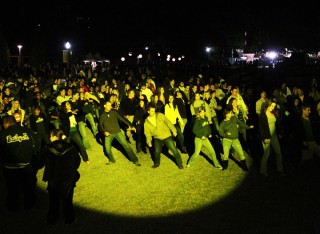
Makenzie Mason | Round Up Photo Editor
By Krista Pirtle
Sports Writer
With people doing the Bernie, Dougie and learning how to wobble, it might be hard to believe that the Baylor dance ban was lifted only 15 years ago.
Because of the close ties between Baylor and the Baptist General Convention of Texas, dancing was viewed as a sin.
But this assumption wasn’t made on the grounds of the music engulfing the atmosphere or the types of dancing that could ensue.
“What happened was, all the things around drinking came to be thought of as sinful,” Dr. Burt Burleson, university chaplain, said. “For instance, if you went to the honky tonk to drink, that’s where you also went to dance. So dancing became problematic.”
There was an old saying about this particular issue: “Baptists don’t smoke, drink, dance, chew or associate with those that do.”
The ban itself arose from the sense of parenthood the university claims over its students.
As a private and religiously affiliated school, the officials believed that in order for its students to flourish, boundaries needed to be set.
“Baylor, in some sense, is akin to a community, a family, in that we try to provide a sense of boundary and I think that probably. . .if you went to a completely secular school, then they would say it’s not our business to create boundaries,” Burleson said. “Baylor would say that would be irresponsible as a community. But here we’re going to say what it means to reflect a wholeness and create boundaries for that.”
The boundaries reflect the sense of a private university, but the beliefs bring in the Christian values.
“By claiming Baptist beliefs and Christian values, Baylor wants to shape its students and guide them in a light pleasing to God,” Burleson said
For dancing to separate itself from its negative connotations, progress had to be made, something that took place over generations.
At Baylor, students came wanting to dance.
But the “d” word was not used on campus. The proper term was “foot functions.”
So students at Baylor loved to (d-word).

Jed Dean | Lariat Photo Editor
Fraternities and sororities would travel up to 100 miles away to hold foot functions. However, the safety of their travel was an issue that aroused as the ban was on the verge of being overturned.
“In 1991, we changed our charter for the very first time so that our regents were more self-appointed,” Burleson said. “Twenty-five percent are still appointed by the BGCT. That’s a real interesting move, saying we are no longer owned and operated by, but more of a partnership with.”
Because this happened, the influence the BGCT had on Baylor was slowly loosened.
Five years later at Diadeloso, Baylor President Robert Sloan Jr., clad in a tuxedo, danced with his wife, Sue, in a sequined evening gown in the middle of Fifth Street to a Beethoven minuet before breaking out in the jitterbug to “In the Mood.”
This action brought in news cameras from all over the nation and was a symbolic overturning the 151-year dance ban.
Nowadays, dances on campus are easy to come by.
In September, Pi Beta Phi hosted the 50th anniversary of the Howdy dance on campus in the Burleson Quadrangle. For many years, the dance was held off-campus, but with the repeal of the dance ban, such events are now commonplace on campus.
“Getting a dance approved on campus is just like getting any other event approved on campus,” Houston senior Zach Rogers, student body president, said. “It’s just like setting up a dinner on campus. There is no specification between a dance and any other event.”
Because of the southern Baptist views on dancing and its sinful implications for so many years, the ban had been enforced for the betterment of the students. Now, Baylor sees no harm in dancing.
“Baylor is trying to be a place of spiritual wholeness, and how that looks changes throughout the years,” Burleson said. “Baylor is responding to the culture, but we’re evolving in what it looks like to be followers of Christ.”
Just like parents letting their children go off to college, Baylor began to see the need to give its students some room for trial and error, to grow and find themselves.
Today, students don’t see dancing as a very serious issue. Dancing is just dancing to them.
“Back in the day, it used to be a huge deal, but it’s just not an issue to most of us kids anymore,” said Quitaque sophomore Lauren Young, who was a member of her high school’s dance team. “We get to have dances on campus and it’s no big deal.”
The negative connotation of dance has been replaced with the understanding that it is a way of life, offering an escape from the real world, if only for a little while.
“Dancing allows me to express myself in ways that speaking can’t,” Cortez, Colo., junior Lauren Houser said. “It communicates those emotions that are too big and too real to fit into words.”
Instead of being a battle with authority for self-expression, dancing has become more of an afterthought.
Baylor tried to break the zumba world record this year at Fountain Mall, Howdy was held in the Quad, the Zeta Zigga Zamma’s Kool-Aid man is everywhere and you just might see Dr. Burleson dancing in chapel.



